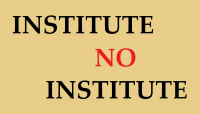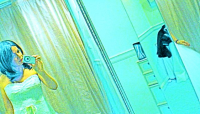Freud as a Thinker of the Political Body: Fear and Distress as Political Affects – Vladimir Safatle in Conversation with Marcus Coelen
“For Freud distress is a prerequisite for social emancipation, not an experience of resignation or vulnerability, a demand for care by proto-parental figures, or a continued political experience of exploitation of fear. What we have in Freud the affirmation of distress as an ontological insecurity with the political function of reducing demand for an authority based on the phantasmagoric constitution of sovereign power. All political action is initially the action of a landslide and only distressed people are able to act politically. Freud shows us how a truly emancipatory politics is based on the affective circulation of experiences of distress, not on building fantasies to defend ourselves against it. In this sense, politics can be thought as a practice that allows distress to appe...Read More
Institute No Institute
Becoming a psychoanalyst is founded upon a subjective transformation that occurs in a personal analysis. It cannot be measured or predicted, yet it is the necessary factor that allows one to conduct analytic treatment. Neither the analyst alone nor a group of independent observers can determine its occurrence, but somehow together they may. That something so difficult to determine lies at the heart of professional transmission has troubled the field of psychoanalysis from its inception. Institutes, schools, and broader communities of psychoanalysts have struggled to harness this transformation to formal models of training. They have invariably encountered obstacles in the structures of authority and the exercise of power. While training outside institutions is not explicitly subject to the...Read More
Jamieson Webster: “Sick Bodies, Hysterical Pregnancies, ISIS Wives”
“Conversion is linked to combustible effects, to desires and fears that remain hidden, unspoken, but ripe, a demand that takes place through the body. This is certainly the situation with the original “conversion hysterics” of psychoanalysis. “I have a sounding board in my abdomen…if anything happens, it starts up my old pain,” said a woman to Breur in Studies in Hysteria (1895, p. 204). Some thirty-odd pages later, Freud takes over, as he would do, this hysteric’s imagery as his own, laying down the foundation for the existence of “unconscious ideas” and the “splitting” of the mind on the basis of her words. Freud writes, “the lively affects into which they are thrown by relatively trivial causes become more intelligible if we reflect that the ‘split-off’ mind acts like a sounding-b...Read More
Tracy Morgan: “To Disembark”
“The denouement of a ten-year psychoanalytic treatment brings to mind the story of Jane Eyre. I was seven years deep into my analysis when I began to have the feeling that, like Jane’s blinded Mr. Rochester, my analyst had lost sight of me. From the precise moment I met Jane, and I can still see her seated in a dark room surrounded by a family not her own, she became a dear companion. Reading this novel in childhood, I was unable to set it down. As I walked to school, took a bath, ate dinner, I read. So intent was I on absorbing Bronte’s words, I parted with them only to sleep. Such was their elixir-like power over a seven year old me. Jane, “a motherless woman,” eventually makes her way as a governess. Late in the novel, and after much hesitation, she accepts the hand of her em...Read More
Interview with Patricia Gherovici: “The Unconscious is the Last Activist”
PATRICIA GHEROVICI: I was first a writer before I became an analyst. I was working as a journalist while I was a student and I did a lot of journalistic writing. There was a continuation of that early career in my practice of analysis. Indeed, the process of analysis could be seen as a process of writing, with the difference that the writing is made by the analysand. A successful analysis works like writing. In some cases, certain novelists use writing as an analysis. When an analysis functions successfully, something similar to what is at stake in writing has to have been produced, and in that sense they are perhaps an extension of each other. There is something that has to do with writing, inscription, and editing that takes place in analysis. They are parallel processes. CASSANDRA SELTM...Read More
Steven Reisner: Just One More Question – New York Times Couch
“Eventually, we came around to my problem, which, of course, had echoes of former problems of mine with which he was familiar. He listened closely and, after a pause, looked me squarely in the eye, and with a deep knowledge of me, said, “You will not be fully yourself until you are wholly aligned with your sexuality.” I tried to soften and generalize what he was saying to me: “You mean my life drive?” He shrugged as if to say, Eh, that’s not quite it. “No, not your life drive,” he said. “That’s not your problem. Your sexuality.” Martin’s generation of psychoanalysts had worked to tame sexuality, focusing instead on a more general need for relationships. This gentler version has become prominent in today’s psychoanalytic circles. But for Martin, this was only half the story. The other...Read More
Katelan Foisy and Vanessa Sinclair: The Cut in Creation
We live in a world of systems, of structure. We are raised to believe that this is inevitable, the natural order of things. Science proves it is so. But what happens when we start to question this order, dare to challenge it? And what would happen if we break it down, disassemble it, cut it up? “The first step in re-creation is to cut the old lines that hold you right where you are sitting now,” William S. Burroughs, The Third Mind (1978). The cut-up method was first created by Tristan Tzara in the early 20th century. Tzara was a member of both the Dada and Surrealist movements. Historically, psychoanalysis has been associated with the Surrealists, as they openly acknowledged the impact of Sigmund Freud’s theories on their work. However, the processes explored within the Dada movement more...Read More
Without History: An Experimental Case Presentation
“For today’s event, we have asked our three analysts to present the same case, which is an ongoing psychoanalysis, being conducted by yet another clinician who’ll remain anonymous. Our three analysts will present this case based on a set of process notes only, without access to case history or other information about the case. Also, no one in today’s audience will have access either to the process notes or to any case history. This includes the event’s planners: neither I nor any member of the planning group has looked at the process notes, nor do we know details of the case. We’ve designed this event so that, aside from the three presenters, everyone else in the room will listen from a radical position of—“not knowing.” We’ve designed this event flexibly, with a number of possible d...Read More
- 1
- 2















